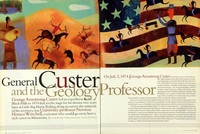After a brief and hastily conducted “retrospective” survey in the fall of 1872, followed by a full year foray filled with salt determinations and peat assessments in 1873, Newton Horace Winchell, the director of the Minnesota Geological and Natural History Survey, State Geologist, Professor of Geology, and Curator of the Museum, left the state of Minnesota.
Don’t be alarmed. Winchell didn’t leave for good – he merely went on a field trip. In the summer of 1874, during the third year of the Survey, Winchell accompanied a “military and scientific expedition” to the Black Hills in the Dakota Territory. The Board of Regents accepted an invitation Winchell received from Colonel Ludlow of the U.S. Army to join the expedition, “it being understood that no part of the expenses shall be borne by the University.” The Regents did however appropriate $100 to Winchell to assist in the collection of specimens for the “general museum” that was to be installed in the main University building (later to be known as Old Main).
The Black Hills expedition departed from Fort Lincoln on July 2, 1874 with an assemblage of U.S. Army troops, reporters, miners, and scientists. The leader of the pack was General George A. Custer, known to us now from his “last stand” at the Battle of Little Big Horn in 1876. From July 2 through the end of August 1874, Winchell studied and documented the geological composition of what he referred to as “the unexplored interior of the Black hills, so long involved in mysterious and legendary uncertainty.”
 The 1874 expedition to the Dakota Territory is a tale of western expansion and encroachment upon Native American lands, economic depression and the search for gold – and it is a tale that has already been told. “General Custer and the Geology Professor” by Tim Brady was first published in Minnesota Magazine, November-December 2000 (accessible on the Digital Conservancy) and again in the book Gopher Gold in 2007 (a highly recommended read).
The 1874 expedition to the Dakota Territory is a tale of western expansion and encroachment upon Native American lands, economic depression and the search for gold – and it is a tale that has already been told. “General Custer and the Geology Professor” by Tim Brady was first published in Minnesota Magazine, November-December 2000 (accessible on the Digital Conservancy) and again in the book Gopher Gold in 2007 (a highly recommended read).
Yet there is more to the story of Winchell’s field trip to the Black Hills, the plot of which concerns the souvenirs that Winchell brought back to the University upon his return. According to the Annals of the Museum of Natural History, Winchell acquired two antelopes, deer with young, an elk head, badger, grizzly bear with young, and a weasel – some of the very first mammals to be mounted and displayed in the University’s museum.
Winchell had to wait to get the museum up and running however, as construction was not yet complete on the University building (Old Main). After much delay, Old Main was completed in 1875, and Winchell moved in to set up the geological specimens and natural history displays acquired by the Survey. A description of the early museum can be found in the “Report of the General Museum,” a special section that first appears in the fourth annual report of the Survey for 1875 (for those that want to read ahead).
We will explore the fourth year of the Minnesota Geological and Natural History Survey and the further development of the “general museum” in a future post.
(Spoiler alert: Do you enjoy taxidermy?)